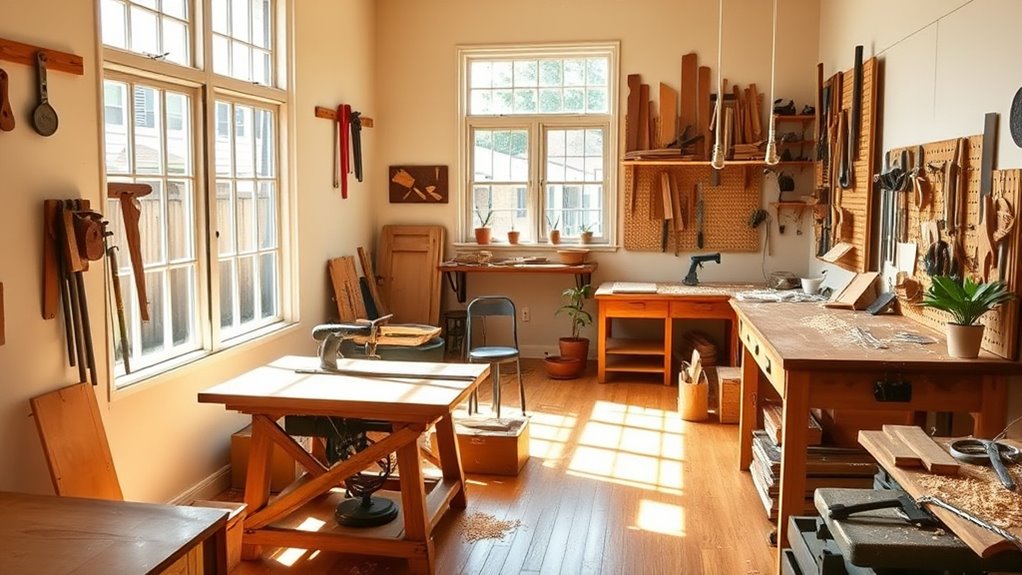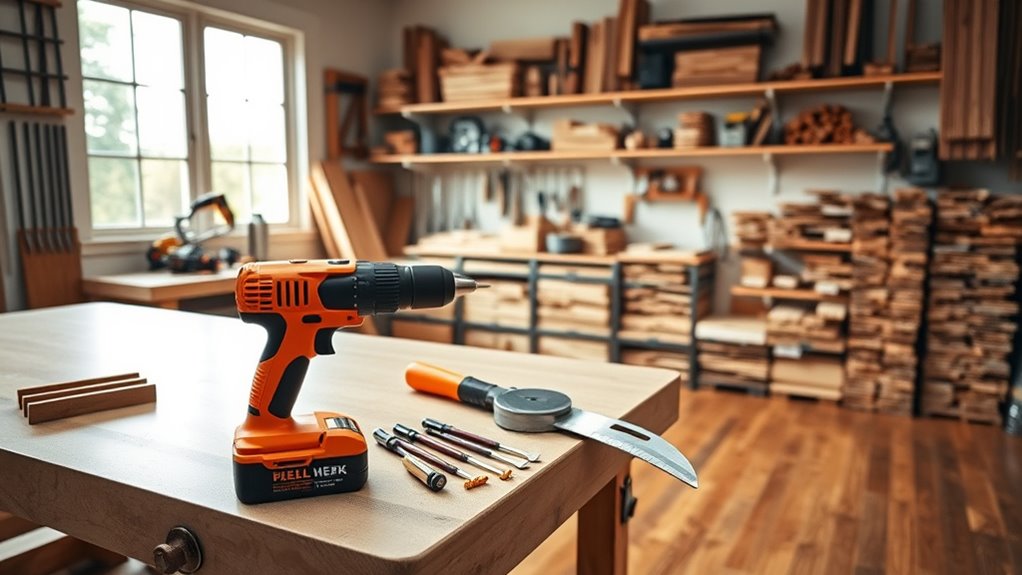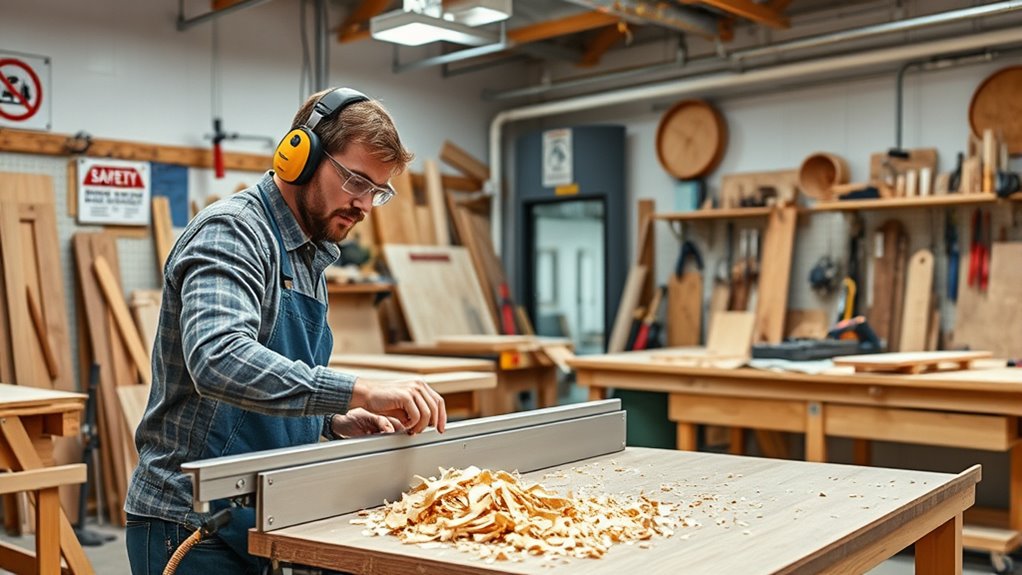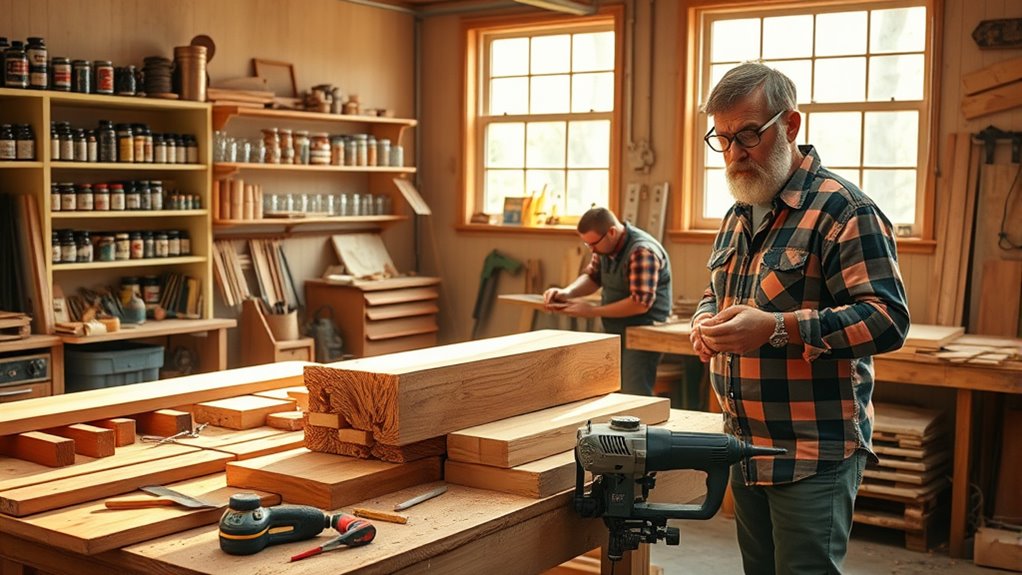To start a woodworking business, you need a clear plan, a suitable workshop in a visible location, and a target market in mind. Secure funding, set a budget, and purchase essential tools while ensuring safety compliance. Develop branding and marketing strategies to attract clients and stay on top of industry trends like eco-friendly products. Focus on quality, niche markets, and customer feedback. If you keep exploring, you’ll uncover detailed steps to turn your woodworking passion into a thriving business.
Key Takeaways
- Develop a clear business plan, including target market, location, and financial goals, to guide your woodworking enterprise.
- Choose a suitable workspace with proper safety, ventilation, lighting, and essential tools for efficient operations.
- Conduct thorough market research to identify niche opportunities, analyze competitors, and understand industry trends.
- Secure funding through savings, loans, or grants, and budget for equipment, materials, marketing, and operational costs.
- Implement safety protocols, build an online presence, and utilize targeted marketing strategies to attract and retain customers.
Crafting a Solid Business Plan

Creating a solid business plan is essential to launching a successful woodworking business because it provides a clear roadmap for your goals and operations. Start by summarizing your business concept, vision, and objectives, so you know exactly what you aim to achieve. Include your mission statement, highlighting core values like craftsmanship or sustainability, and specify your key products or custom services. Decide on your business structure—whether it’s a sole proprietorship, LLC, or partnership—to understand legal and financial responsibilities. Outline your financial goals and milestones to attract potential investors and guide your growth. A well-crafted plan keeps you focused, helps identify potential challenges, and guarantees your woodworking enterprise has a strong foundation for long-term success. Be sure to incorporate financial planning to prepare for expenses and profitability, and consider market analysis to better understand your target audience and competition. Additionally, conducting a thorough branding strategy can help differentiate your business in a competitive market. Understanding production quantity variance can also assist in managing manufacturing efficiency and cost control, ensuring your operations stay profitable. Incorporating industry trends can help you stay ahead of market shifts and adapt your offerings accordingly.
Choosing the Right Business Name

Selecting the right business name is a critical step in establishing your woodworking enterprise, as it sets the tone for your brand and influences customer perception. You want a name that’s memorable and stands out, not something generic like “Quality Woodworking.” Keep it simple and easy to pronounce, so word-of-mouth spreads naturally. Incorporating elements of creative branding can help craft a distinctive identity that resonates with your target audience. Aim for a name that reflects your craftsmanship or unique selling point, helping customers connect emotionally. It should also be adaptable for future growth or product lines without becoming a limitation. Incorporate relevant keywords related to woodworking for better searchability and recognition. Consider popular themes like combining woodworking terms with creative words, nature-inspired names, or clever puns. Checking domain availability and trademarks, and testing your choices with potential customers to ensure your name resonates and is easy to recall, are essential steps. Additionally, aligning your business name with hybrid concepts in branding can enhance versatility and appeal across diverse markets. For example, exploring Pinball Machine themes or incorporating modern innovations can inspire unique branding angles that set your business apart. Incorporating water-related themes can also evoke a sense of fluid craftsmanship and quality, appealing to a broad audience. Being aware of how copyright and trademark considerations impact your branding choices can help you avoid legal issues and protect your business identity.
Conducting Effective Market Research

To build a successful woodworking business, understanding your market is essential, and conducting effective market research is the first step toward that goal.
Start by identifying your target customers through surveys and social media analytics to learn their needs and preferences.
Analyze your competition using SWOT analysis and industry reports to spot market leaders and strategies.
Research current trends, such as sustainable materials or home decor styles, to stay ahead.
Look for niche opportunities by examining unmet needs and regional demands, then tailor your products accordingly.
Use tools like Porter’s Five Forces to understand industry structure and competition.
Regularly monitor customer reviews and feedback to refine your offerings.
Leveraging digital platforms helps you gather data, promote products, and connect with your audience more effectively.
Additionally, exploring essential oil benefits and applications can inspire creative marketing angles, especially if you plan to incorporate natural or aromatic elements into your brand identity.
Securing Initial Funding and Budgeting

Securing initial funding is a critical step when starting a woodworking business, and there are several options you can explore. Your first choice might be personal savings, which is common and straightforward. You can also consider borrowing from family and friends, often with favorable terms. Small business loans, such as SBA-backed or traditional bank loans, provide reliable funding with fixed repayments. Business lines of credit and credit cards offer flexible options if you need quick access to cash. Crowdfunding platforms like Kickstarter or GoFundMe allow you to raise funds from a broader audience. Once you have funding, budgeting for essential tools, machinery, materials, marketing, and digital infrastructure is essential. Proper planning ensures you can cover startup costs and set a strong foundation for your woodworking business. Additionally, understanding tiny house resources can help you explore options for land and building considerations that may impact your business planning. Considering cost-effective building options can also help optimize your initial investments and expand your workshop’s capabilities. Leveraging AI tools can further streamline your planning process and improve operational efficiency as you grow. Exploring alternative funding sources such as grants or angel investors may also provide additional financial support for your venture.
Finding an Ideal Workshop Location

Finding an ideal workshop location requires careful consideration of several key factors that can impact your business’s success.
First, make certain the site is easily accessible for deliveries and shipments. You’ll need enough space—around 75 square feet or more—to comfortably set up workbenches, tools, and machinery. Proper ventilation and lighting are essential for safety and productivity, so evaluate the existing setup or plan to upgrade. Noise levels matter, especially if you’re near residential areas; soundproofing might be necessary. Also, think ahead about expansion opportunities as your business grows. Consider local zoning laws, safety regulations, and proximity to suppliers to minimize costs. Size restrictions imposed by local building codes can influence your choice of workshop space, so researching these regulations beforehand is important. Additionally, staying informed about local regulations and potential promotional offers can help you find a cost-effective and compliant space. Planning for future growth can ensure your workshop remains adaptable as your woodworking business expands. Moreover, understanding industry standards can help you meet safety and quality requirements from the outset. Implementing automation tools in your workflow can further improve efficiency and accuracy, especially as your operations scale. Finally, choose a location that’s accessible and visible to potential clients, boosting your chances of attracting business.
Essential Tools and Equipment for Your Shop

Equipping your woodworking shop with the right tools and machinery is crucial for producing quality work efficiently. A sturdy table saw is your core, perfect for ripping and crosscutting with precision. Pair it with a router for detailed edges, joints, and hollows. An orbital sander ensures smooth finishes, while a bandsaw handles curved cuts and resawing. A dust collector keeps the air clean and safe.
Stationary tools like a jointer and planer prepare rough lumber by flattening and achieving uniform thickness. A compound miter saw provides precise angle cuts, and a drill press offers accurate drilling. Hand tools such as chisels, hand planes, and clamps are indispensable for fine details and assembly.
Safety gear like respirators, goggles, and hearing protection protect you throughout every step.
Developing a Marketing Strategy

Developing a strong marketing strategy is essential for growing your woodworking business and attracting new clients. Start by building a professional website with galleries, contact forms, and service details to showcase your craftsmanship.
Launch a woodworking blog sharing tutorials and industry insights, and optimize your content for local SEO to boost visibility.
Claim and regularly update your Google My Business listing to attract nearby customers.
Use content marketing by creating YouTube videos, email newsletters, and downloadable guides to engage your audience.
Collaborate with influencers, host open-house events, and partner with local vendors for cross-promotions.
Prioritize visual platforms like Instagram and Pinterest to display your projects.
Run targeted social media ads, and track engagement to refine your efforts.
Adjust your strategies quarterly based on results.
Creating and Managing Your Product Line

Creating and managing your product line is a crucial step in building a successful woodworking business, as it directly influences your market position and customer satisfaction.
Focus on specialization by honing in on specific areas like furniture or wood carving to stand out.
Keep an eye on market trends, such as eco-friendly products made from reclaimed wood, to appeal to conscious consumers.
Offer unique, personalized items to attract customers seeking one-of-a-kind pieces, and prioritize high-quality standards to build your reputation.
Continuously research market needs and adapt your offerings accordingly.
Balance product diversity with your skills and resources, and gather customer feedback to refine your line.
This strategic approach ensures your product line remains relevant, competitive, and aligned with your brand’s identity.
Financial Planning and Cost Management

Effective financial planning and cost management are essential for turning your woodworking business into a sustainable venture. Start by estimating startup costs, including tooling, machinery, and raw materials.
Proper financial planning and cost control are key to building a sustainable woodworking business.
Don’t forget facility expenses like leases, deposits, and renovations to improve efficiency. Budget for mandatory costs such as licensing, insurance, and business registration.
Invest in technology like design software and financial tools to enhance accuracy. For funding, consider a mix of owner investment, loans, or leasing options to balance cash flow and costs.
Develop detailed cash flow forecasts, segmenting operational, investing, and financing activities to stay on top of liquidity. Maintain cash reserves for unexpected expenses.
Use accounting software to track expenses and income, helping you stay financially disciplined and prepared for growth.
Implementing Safety and Operational Protocols

Implementing safety and operational protocols is essential to maintaining a secure and efficient woodworking shop. You must enforce PPE use, including eye and hearing protection, at all times. Never leave machines running unattended, and keep floors free of debris to prevent slips.
Ensure all workers are trained on each machine before use and avoid loose clothing or jewelry that could get caught. Maintain dust collectors during and after operation, and ensure proper ventilation when working with chemicals.
Install and regularly check machine guards, and keep fire extinguishers accessible. Develop clear SOPs, designate work zones, and regularly inspect tools and safety measures.
Conduct safety training, encourage employee feedback, and stay compliant with OSHA and local regulations to minimize hazards and promote a safe environment.
Frequently Asked Questions
How Do I Choose the Best Woodworking Niche for My Skills?
To pick the best woodworking niche for your skills, first assess what you’re really good at and enjoy making. Think about the tools you have and your experience level.
Research market trends and see what’s in demand, like custom furniture or small decorative items.
Focus on a niche that matches your expertise and interests, so you stay motivated and can produce high-quality, unique pieces that buyers will love.
What Permits and Licenses Are Required to Start Woodworking Business?
You might worry about complex permit requirements, but most woodworking businesses need only basic licenses. You’ll need a sales tax permit if selling tangible goods, and possibly local licenses depending on your city or county.
Confirm you’re compliant with zoning laws and environmental regulations. Additionally, obtaining liability insurance and, if hiring, workers’ compensation is essential.
Staying informed about these permits keeps your business legal and protected as you craft your woodworking dreams.
How Can I Effectively Price My Custom Woodworking Products?
To effectively price your custom woodworking products, consider your material costs, labor, and overhead expenses.
Use pricing strategies like cost-plus or value-based pricing to guarantee profitability.
Research your market to understand demand and competition, and gather customer feedback to refine your prices.
Utilize tools like spreadsheets or pricing software to organize costs and set competitive, fair prices that reflect your craftsmanship and the product’s perceived value.
What Insurance Coverage Do I Need for a Woodworking Workshop?
When considering your workshop, you need general liability insurance to protect against third-party injuries and property damage.
And product liability insurance if you make furniture or custom pieces.
Also, get property insurance for your tools, equipment, and workspace.
Plus, workers’ compensation if you have employees.
You might also need inland marine coverage for tools in transit and commercial auto insurance if you use vehicles for business.
How Do I Build a Strong Online Presence for My Woodworking Brand?
To build a strong online presence for your woodworking brand, focus on creating engaging content across platforms like YouTube, Instagram, and Facebook. Share detailed tutorials, stunning visuals, and behind-the-scenes glimpses to attract followers.
Use social media management tools to schedule posts and analyze performance.
Connect with industry influencers and join woodworking groups to grow your network.
Regular updates, authentic storytelling, and active community engagement will establish your credibility and expand your reach.
Conclusion
Starting your woodworking business is like building a sturdy ship—you need a solid plan, the right tools, and a clear course. Stay focused on your goals, adapt as you go, and keep safety at the forefront. With dedication and smart decisions, you’ll navigate the waters of entrepreneurship smoothly. Remember, every successful craftsman started with a single cut—trust in your skills, and your business will sail toward success.









